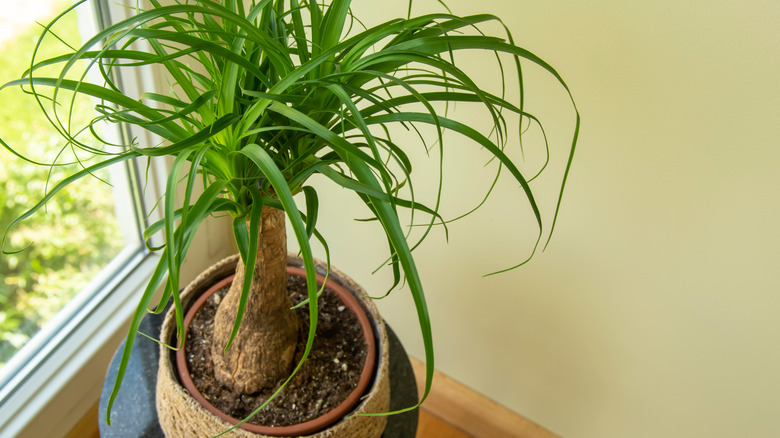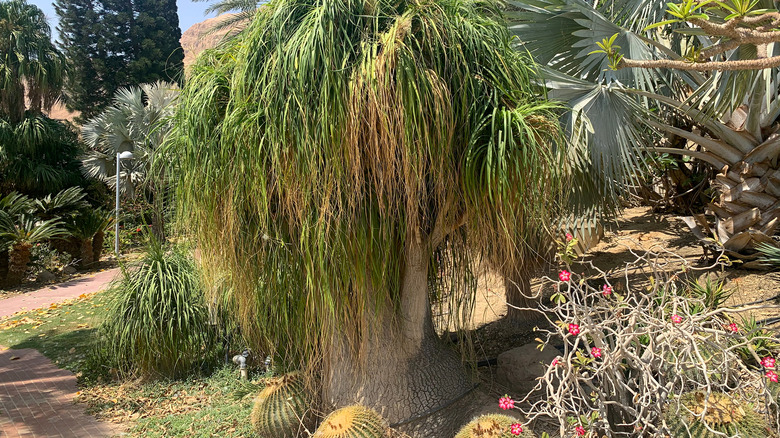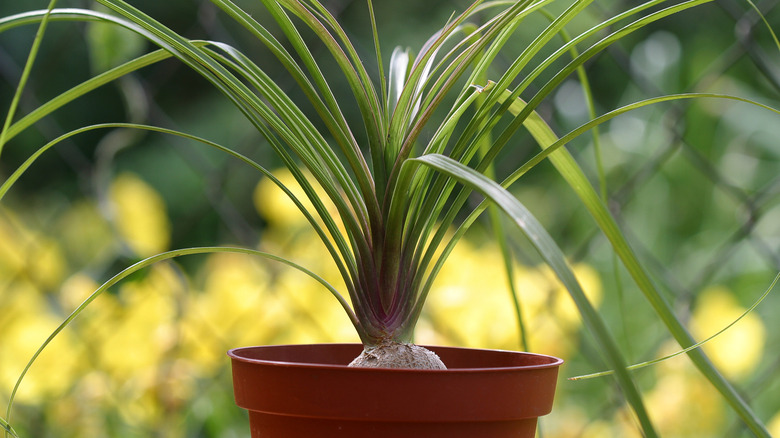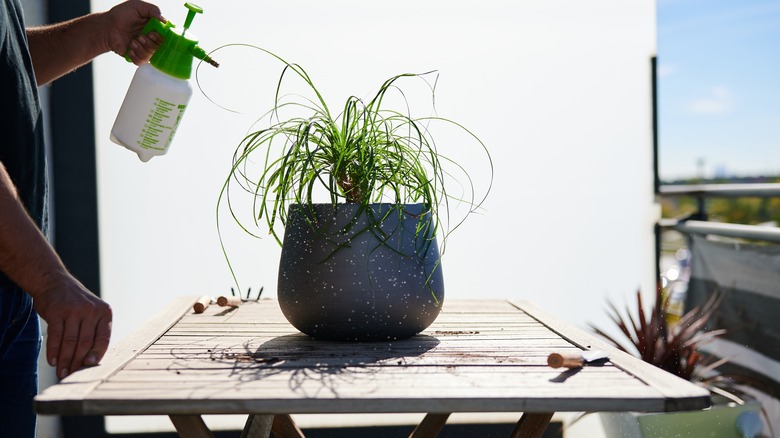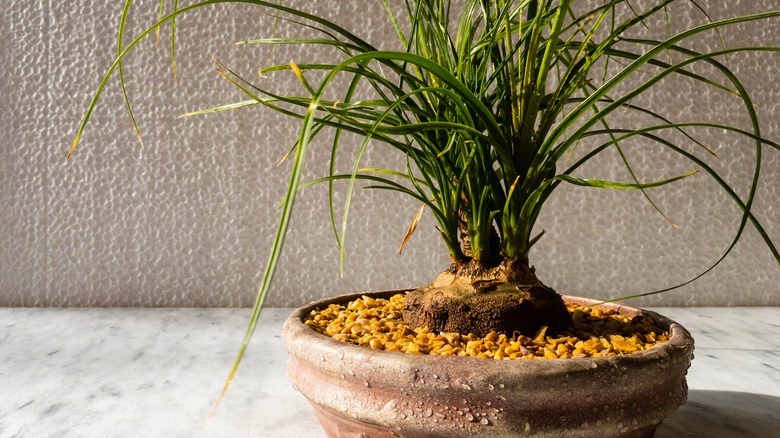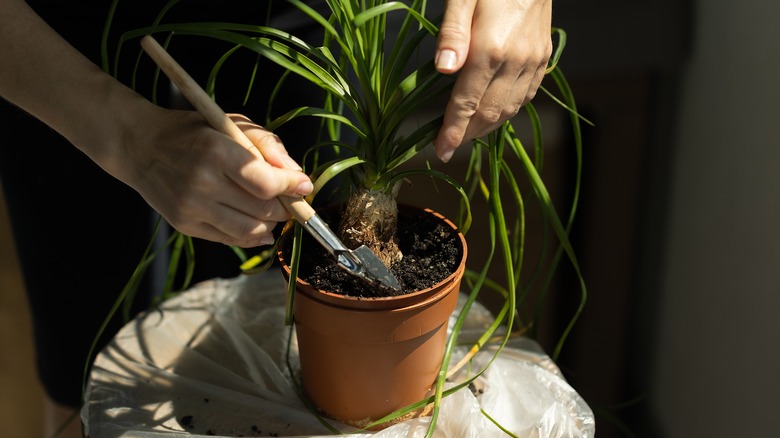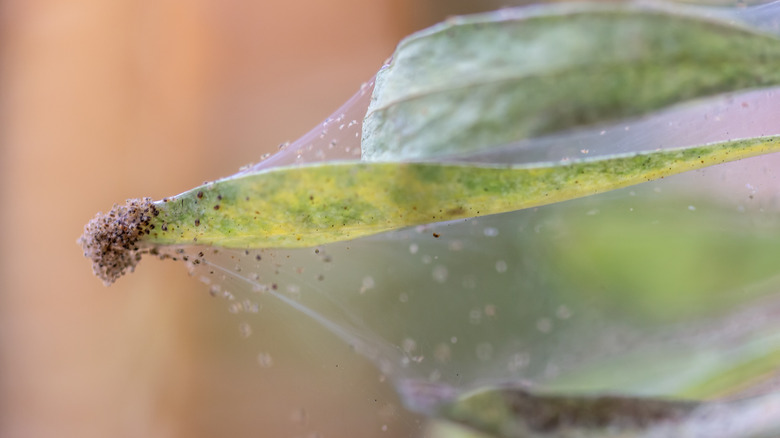How To Grow And Take Care Of A Ponytail Palm
Beaucarnea recurvata, also known as the ponytail palm or elephant's foot, is a common houseplant in the U.S. and Europe. Its name 'ponytail palm' is actually misleading because the plant is not a palm at all, said The Spruce. It is a member of the asparagaceae family along with garden asparagus, agave, and yuccas. Ponytail palms make wonderful desk or corner plants depending on their height. Mature ponytail palms kept indoors can grow as large as 8 feet tall. Outdoor ponytail palms can become taller than 20 feet. Though, it's unlikely that you'll see beaucarnea recurvata outside unless you live in USDA zones 10 or 11.
Ponytail palms can be identified by their bulbous trunk and long, thin leaves that look like a green head of hair. The plant's appearance will make you think of tropical forests, yet it doesn't need humid air and frequent watering to survive. In fact, your ponytail palm prefers the opposite. In the wild, this plant likes arid climates found in the desertic areas of Southeastern Mexico and Central America, according to Gardener's Path. This makes it an incredibly forgiving houseplant. It will live happily in a sunny window with little attention.
How to use a ponytail palm in the garden
It's possible to grow a ponytail palm outdoors if you live in the most southern parts of Texas, California, Arizona, or Florida. If you are planning to introduce this plant into your landscape, keep in mind that it is slow-growing. Most people choose to grow theirs inside for sometime before keeping it in a container on their porch and eventually moving it into their garden, as reported by Gardening Know How. This is because ponytail palms can be shocked by a sudden change in environment. They need to be slowly introduced to new levels of sunlight and temperature changes.
In southern Florida, you will often see ponytail palms planted in front lawns. They create a dramatic tropical look while also creating some shade on your home. Ponytail palms are not picky when it comes to soil. As long as water can drain out easily, they can survive. This makes them a great plant to place in rock gardens or a sandy or loamy area of your property.
How to grow a ponytail palm
Ponytail palms are known to be the kind of thing you can plant and forget. Growing this plant takes little effort, especially when kept indoors. To get started with your ponytail palm, as per Gardener's Path, you'll need loose cactus and succulent potting mix, a pot with a drainage hole, and a sunny window. You can buy one of these plants at your local nursery, start them as seeds, or grow them from propagation. Starting your ponytail palm from seeds is not recommended by many gardeners. The plant is extremely slow-growing, and it will take a long time before you see the results you're looking for. However, if you would like to try, you can follow these steps. Begin by scratching the seeds' surface with something abrasive and soak them in water overnight. Then, plant them in a shallow pot filled with the potting soil. Always keep the soil moist and warm. Covering the pots with plastic wrap will help create a greenhouse effect. Your seeds should sprout after several weeks or months.
To propagate a ponytail palm, you'll need one or more offshoots from a mature plant. You can buy these online or find a friend willing to share theirs. If you are dividing the offshoot on your own, use a sanitized knife to cut the piece from the ponytail palm through its roots. Once divided, you can plant and water the pup as normal.
How to care for a ponytail palm
All you need to do to help your ponytail palm thrive is give it plenty of sunlight and a little water. Potted indoor ponytail palms should be watered two to four times per month during their growing season, according to The Spruce. Make sure to water yours generously until water runs out of its pot's drainage hole. Throw out any excess water in the saucer to combat root rot and similar diseases. After a good watering, you won't need to tend to your plant again until its soil has completely dried out. A ponytail plant should be in bright indirect sunlight or direct sunlight at all times. Your plant will be happiest in the brightest location in your home.
Like other members of the asparagaceae family, ponytail palms do not require fertilization to survive. Yet, your plant will appreciate it if you take some time to fertilize it once or twice monthly during its growing season in the spring, as said by Better Homes & Gardens. Simply use an all-purpose liquid fertilizer or cactus and succulent liquid plant food to feed when it suits you.
Ponytail palm varieties
There are only 13 species of beaucarnea accepted by the Royal Botanical Gardens, KEW. Each of them is native to Mexico as well as many Central American countries such as Belize, Guatemala, and Nicaragua. The ponytail palms share many of the same traits, which can make them hard to differentiate. Here are five of the most popular species in the beaucarnea genus.
-
"Beaucarnea recurvata albomarginata" or "Gold Star": It is almost identical to the common ponytail palm but with one stark difference. This variety features streaks of light green on the edges of its leaves.
-
"Beaucarnea gracilis": This species of beaucarnea comes from Central and South Western Mexico. You can identify this plant from its dull, blue-green foliage.
-
"Beaucarnea compacta": This is a cousin to beaucarnea recurvata native to North Eastern Mexico; as its name suggests, it doesn't grow very tall. In fact, most of its height comes from its bushy leaves.
-
"Beaucarnea goldmanii": Another close relative to beaucarnea recurvata, this plant has a much skinnier trunk and can grow up to 40 feet tall.
- "Beaucarnea stricta": The name, stricta, refers to its thin, straight leaves, which form a dome around the head of the plant. It is native to the dry forests of Oaxaca, Mexico.
How to repot a ponytail palm
The frequency with which you repot your ponytail palm will depend on its growth. If your plant is growing steadily, and you want it to keep growing, you'll want to repot it every year. Yet, if you are trying to restrict your ponytail palm's growth, only repot it every two to three years, as told by Our House Plants.
You should only repot this plant in the spring. To do so, you should find a pot that is only slightly bigger than the last. Keep in mind that ponytail palms enjoy being in a container that confines them. Choose a pot that is only about 2 inches larger than the plant's base. The steps for repotting this plant are no different than any other plant you have in your home. Remove the ponytail palm from its original pot. If your palm is quite big, setting it on its side and loosening it from the edge with a flat tool helps. Then, gently remove the excess soil from its roots before placing it in a new pot with a fresh cactus and succulent potting mix. Water your repotted ponytail palm generously before leaving it in a sunny spot.
Ponytail palms common pests and diseases
Like many other houseplants, explained The Spruce, ponytail palms are threatened by a few pests and diseases that can be dealt with somewhat easily. Insects such as spider mites, scale, and mealybugs are the most common pests. You can identify spider mites by the yellow spots they leave on the leaves of your ponytail palm. With a severe infestation, you may also notice small webs or gray dust in the same areas. Scale is a small oval-shaped insect that has dark and light brown spots or stripes. Mealybugs look similar, but they are white, sometimes appearing to be pieces of dust. All of these pests can be killed in the same way. Rubbing alcohol may be rubbed onto the leaves and trunk of the ponytail palm, or neem oil may be applied according to the directions on the bottle.
Bacterial leaf streak, leaf spots, and stem rot are the diseases that ponytail palm plants most often contract. Typically, every one of these issues is the result of overwatering or high humidity, said Gardener's Path. If you begin to notice your palm's leaves yellowing or its roots becoming mushy, you are likely watering it too much. Cut back on your watering schedule and consider repotting your plant to cut off the affected roots.
